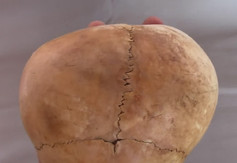A Second Starchild Skull?
- amy011
- May 14, 2015
- 3 min read

Brien Foerster, a researcher specializing in the unusual Peruvian skulls commonly known as "coneheads", recently announced the discovery of a second "Starchild Skull" in Peru. The Starchild Project has worked with Brien Foerster in the past as we attempted to facilitate DNA testing on the conehead skulls, but we are not associated in any way with this new discovery.
The Peruvian skull Foerster has revealed is considerably smaller than the Starchild Skull and seems to be missing the occipital bone (rear of the skull). The Starchild Project has not been able to examine the skull, and at this time is not in a position to make any definitive statements about it, but as so many of you have contacted us looking for answers we have decided to give you our first impressions, which we will revise if needed as more information becomes available.
It is difficult to tell from the images publicly released so far, but it appears that the eye sockets of the Peru skull are roughly normal human depth, and as the occipital (rear) bone is missing, we cannot determine whether it shared the missing inion that is such a notable feature of the Starchild Skull. By comparing the size of the Peru skull to the hand holding it, the skull seems to be in the range of 40% smaller than the Starchild Skull. The configuration of the bones in the Peru skull seems to be consistent with that of a newborn or a very young infant.

Starchild Project co-founder and former neonatal nurse Melanie Young has observed that the line in the forehead of the Peru skull that Foerster described as a “strange cut” is in fact the last stage of the two halves of the frontal bone fusing together. In a fetus, the frontal bone (the bone that makes up the forehead) is divided into two bones which rapidly fuse together into a single solid bone after birth. The “strange cut” is the last stage of those two plates joining together (shown with a green arrow, right).
This, combined with the open fontanel (the “soft spot”, or hole at the top of the head, shown with a blue arrow, right), the degree of suture closure and fusion (how the bone plates that make up the skull have grown and fit together), and the size of the skull, suggests that it is likely to be the skull of a newborn or infant.
If it is the skull of a baby then it is more easily dismissed as a deformity, since it is plausible that a severely deformed child would not live long past birth. This is in contrast to the Starchild Skull which lived long enough to grow and wear down teeth, something that should not have been possible for any human born so abnormal. The Starchild Project is not claiming that the Peru skull is a deformity, and we are not dismissing it, but these are all points we are considering as we review the current evidence. We look forward to more details becoming available about this new discovery.
Whether or not the Peru skull is a second Starchild Skull, the Starchild Project believes that our ongoing DNA testing remains the best way to find the answers we all seek about this strange being. After years of laying the groundwork with research and other testing while the technology capable of sequencing such unusual DNA was developed, the Starchild Project is literally at the final hurdle. Only the need for funding to complete the DNA testing stands in the way. Please consider making a donation if you can, or sharing us on social media, telling your local media to get in touch with us to do a story, or even emailing this article to a friend. Your support is making this historic research possible.
CLICK THE IMAGES BELOW TO ENLARGE
















